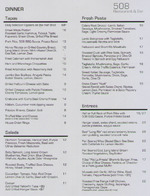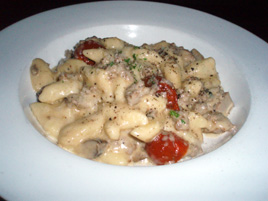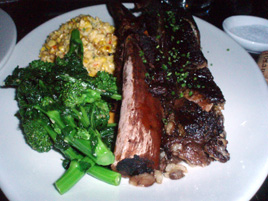The Café at Le Cirque
 Friday, December 4, 2009 at 09:16AM
Friday, December 4, 2009 at 09:16AM 

Like most luxury restaurants these days, Le Cirque has a formal dining room and a dressed-down café, where reservations aren’t taken and the menu is a bit more approachable.
Since our meal in the main dining room almost two years ago, Le Cirque has acquired a new chef: Craig Hopson, formerly of Picholine and One if By Land, Two if By Sea. None of the city’s major critics has reviewed Le Cirque since Hopson took over. It holds three Times stars, courtesy of a Bruni re-review in February 2008. It almost pained him to dine there:
At Le Cirque you will indeed eat too much food, of a kind that neither your physician nor your local Greenpeace representative would endorse, in a setting of deliberate pompousness, at a sometimes ludicrous expense.The ravioli, all three of them, are $35.
But that has long been the way of certain restaurants, which exist to be absurd, to speak not to our better angels but to our inner Trumps, making us feel pampered and reckless and even a little omnipotent, if only for two hours and three courses with a coda of petits fours.
And while I’m not calling for the spread of these establishments (or the massacre of Chilean sea bass), I’m charged with noting when one of them fulfills its chosen mission with classic panache. Le Cirque now does.
Has ever a critic awarded three stars to a restaurant, while saying that he would prefer to see no more like it?
I had an evening commitment on the Upper East Side during Restaurant Week, and as Le Cirque would be on the way, I decided to drop in. The Dining Room was fully committed, even at 5:45 p.m., but the adjoining café was empty (it would begin to fill up later on). The website advises: “Jackets are required for gentlemen in the dining room and suggested in the café.” I was wearing one, but it did not seem to matter.
The café is a comfortable space, dominated by a huge cylindrical wine tower. In the oddly-shaped room, two of the walls have ceiling-height windows that face on Third Avenue and 58th Street, admitting plenty of natural light.
Lately, the owners have been struggling to fill the café. Evidently, the idea of dropping into Le Cirque for an order of sliders hasn’t caught on. Offers to drop in for free fried chicken to watch major sporting events (sixth game of the World Series; Thursday night Jets–Bills game) have dropped in my mailbox with regularity.
There is a dizzying array of options at Le Cirque. The main carte offers a pre-theatre prix fixe at $48, a tasting menu at $120, and a regular prix fixe at $95. You can also order à la carte, which I don’t recall before, with some of the highest prices in town: appetizers $25–30 (most in the high 20s), pastas $28–38, mains $42–70.
The café menu, also called the wine bar menu, has tasting plates from $14–35, along with a three-course “restaurant week” prix fixe for $35, which was available all summer long. Apparently you can order from any of these menus in the café, but the server gave me only the restaurant week menu, as they said it’s what most of the café visitors want.
No one should be under the illusion that they’re getting a $98 value for $35. When the price for three courses is less than the cheapest dining room entrée, you’re obviously not going to get the restaurant’s best stuff. None of the three dishes I had is shown on the main dining room carte. But I did have a modestly satisfying meal at a respectable price, with two forgettable dishes and one I would happily order again.


Gnocchi with tripe ragu (above left) was pedestrian, but I loved (at the price) the pavé of veal with zucchini, tomato, and pecorino romano (above right). The veal was nicely crisped, but tender on the inside. I was afraid of another humdrum tomato broth, but both the tomato and the zucchini were vibrantly flavored. The cheese didn’t add much, though.

Dessert, a lemon merengue pie, was competently executed but rather ordinary, and the accompanying sorbet paired with it poorly.
Café diners get the same bread service as the main dining room—not that it is anything to write home about. Coffee ($4) came in its own silver pot. Service overall was attentive and pleasant. The café has its own pared-down wine list (though I’m sure you can get the bigger one), and prices by the glass are reasonable. A 2003 Haut Médoc was $15.
It may not offer the main dining room’s culinary fireworks, but the Café is a fine way to enjoy an inexpensive dinner if you happen to be in the area.
The Café at Le Cirque (151 E. 58th Street between Lexington & Third Avenues, East Midtown)







































